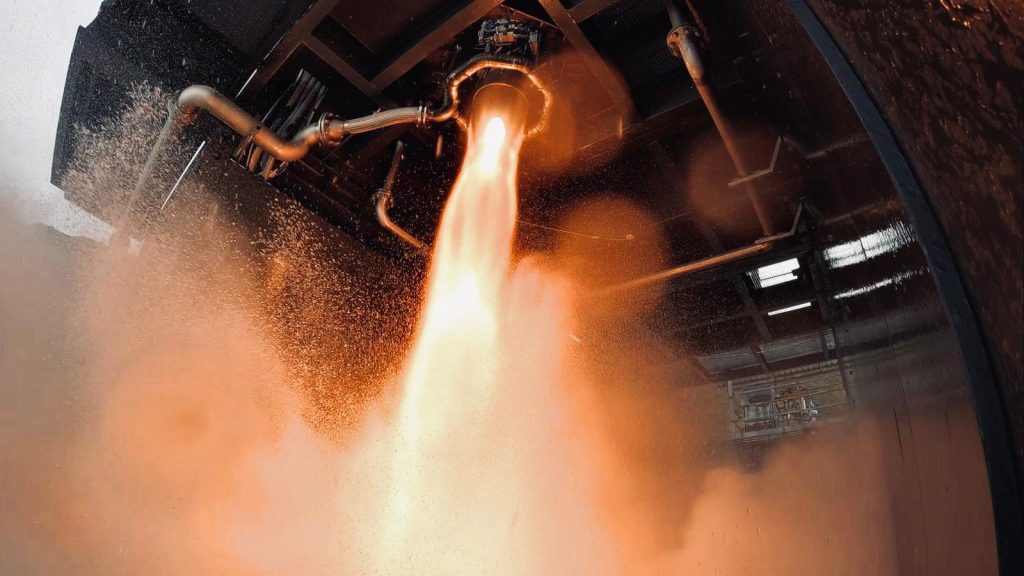Edinburgh-based private rocket manufacturer Skyrora has begun full-duration testing to qualify the updated design of its 3D printed 70kN rocket engine. Skyrora’s Skyprint 2 3D printers have been used to 3D print the new rocket engines, reportedly cutting production times by 66% and costs by 20%.
Set to be used for the company’s first commercial orbital launch, the new engine design features an improved cooling chamber. This will optimize cooling efficiency, extending the engine’s life cycle.
Once successfully completed, the testing will mark a key milestone in Skyrora’s contract under the European Space Agency (ESA)’s Commercial Space Transportation Services and Support Programme, also known as Boost!
Testing is taking place at Skyrora’s Midlothian test site, the largest of its kind in the UK, and will continue to be overseen by the company’s team of experts throughout the summer. Skyrora’s project plays a key role in ongoing efforts to re-shore industry in the UK and Europe, securing supply chains and growing the UK space sector.
“With our purpose-built rocket manufacturing and testing facilities in Scotland, we are proud to be localizing as much of the launch value chain as possible,” commented Skyrora CEO and Founder Volodymyr Levykin. “The new engine technology developed by Skyrora’s engineers and the commitment to a sustainable design are a testament to the innovation taking place in the UK space sector.”
Testing Skyrora’s updated 70kN rocket engine
The engine tests will run for 250 seconds each, the same duration of a real mission to orbit. Various parameters, including life cycle and full operational envelope assessments, will be evaluated during the engine testing process.
Taking approximately three weeks to complete, a full test article iteration consists of data analysis, design adjustments, and manufacturing. Ultimately, a successful test will be indicated by nominal chamber pressure and thrust levels with no damaged hardware.
Once fully tested and qualified, the updated 70kN will become the first commercial rocket engine to use a closed-cycle combustion system run on a propellant combination of Hydrogen Peroxide and Kerosene. Historically, such engines have not been used due to their complexity. However, the higher specific impulse generated through Skyrora’s design is said to significantly increase the overall efficiency of the engine.
Skyrora’s Head of Engineering, Dr Jack James Marlow, stated that “We’re coming very close to finalizing our engine qualification programme after a long journey of technical progress, which will be a massive success for the team.”
“This is a key milestone which will qualify one of the main subsystems of our orbital launch vehicle to the correct standards for commercial operations, and as such, is a significant step in the journey to orbital launch,” continued Marlow.

Scaling and commercializing UK-based space flight
“The new models of 3D printed engines are bringing Skyrora closer towards efficient commercial orbital launch,” claims Levykin.
Indeed, with additional support from ESA’s Boost! programme, the updated engine design will act as a critical component on the first and second stages of Skyrora’s XL orbital vehicle.
Skyrora will also collaborate with the National Manufacturing Institute of Scotland (NIMIS) to qualify the machine, materials, and process of machining for Skyprint 2. These qualifications will allow Skyprint 2 to be used by third parties commercially, diversifying the company’s offering within a new space market.
“Skyrora is making important progress towards the 70kN engine qualification, which is one of the key objectives of the pre-commercial launch service development activities supported by ESA’s Boost! Programme,” commented Jorgen Bru, Commercial Services Manager at the European Space Agency. “ESA is continuing to support Skyrora along the way to offer new commercial launch services for the benefit of a competitive space sector in Europe.”
Skyrora claims that, once qualified, it will be able to scale up production. Once the engine qualification programme is completed, the company plans to manufacture a series of production engines to test the full first stage of Skyrora XL.
This is the final testing stage prior to a demo orbital launch. This full stage test will follow the successful testing of the third and second stages of Skyrora XL in 2020 and 2022 respectively. Last year’s second stage test was the largest of its kind to be conducted in the UK since the 1970s.
In addition to engine qualification, Skyrora has been working closely with the UK Civil Aviation Authority (CAA) to progress their orbital launch vehicle license application, which was submitted last year. Once approved, the license will allow Skyrora to commence commercial launch operations from SaxaVord Spaceport in the Shetland Isles.

3D printed space rockets
The use of additive manufacturing for the production of space rockets is nothing new. Earlier this year, Australian heat transfer specialist Conflux Technology partnered with German space rocket manufacturer Rocket Factory Augsburg (RFA) to embed their 3D printed heat exchanger into an orbital rocket.
Part of the Australian Space Agency’s Moon to Mars initiative, the heat exchanger components are 3D printed using Conflux Technology’s Monel K 500 metal alloy material and EOS M300-4 Direct Metal Laser Sintering (DMLS) 3D printers.
Elsewhere, in April Relativity Space launched the world’s first 3D printed rocket, the Terran 1, marking a significant step forward for additive manufacturing’s role within the space industry. After launching from Cape Canaveral Space Force Station in Florida the rocket, 85% of which is 3D printed, ultimately failed to reach orbit. Yet, the Terran 1 launch was heralded as a success by Relative Space, which intends to increase the 3D printed mass of future vehicles to 95%.
Subscribe to the 3D Printing Industry newsletter to ensure you keep up with the latest 3D printing news. You can also follow us on Twitter, like our Facebook page, and subscribe to the 3D Printing Industry Youtube channel to access more exclusive content.
Are you interested in working in the additive manufacturing industry? Visit 3D Printing Jobs to view a selection of available roles and kickstart your career.
Featured image shows the Skyrora 70kN rocket engine in action. Photo via Skyrora.


